Developing your skills in EDM production entails understanding various key aspects of this music genre.
Chord progressions, pivotal to creating a compelling track, are among the most crucial elements you need to grasp.
By mastering these, you facilitate the creation of catchy hooks and harmonious melodies that make EDM so addictive.
Regardless if you’re a novice or if you’re looking to refine your skills further, becoming adept at these progressions is vital.
In this article, we will delve into some of the most indispensable chord progressions that will elevate your EDM-producing capabilities.
Utilizing these consistently will undoubtedly enhance your craft, pushing your musical creations to a whole new level.
Table of Contents
- Essential Edm Chord Progressions
- I-V-vi-IV (1-5-6-4)
- ii-V-I (2-5-1)
- V-vii°-iii-IV (5-7-3-4)
- I-vi-IV-V (1-6-4-5)
- I-IV-V (1-4-5)
- iii-vii°-ii-V (3-7-2-5)
- ii-IV-V (2-4-5)
- I-vii°-IV-iii (1-7-4-3)
- vii°-iii-vi-V (7-3-6-5)
- I-ii-IV-V (1-2-4-5)
- vi-vii°-IV-V (6-7-4-5)
- I-iii-vi-ii (1-3-6-2)
- I-iii-IV-V (1-3-4-5)
- vi-V-IV (6-5-4)
- vi-ii-V-I (6-2-5-1)
- IV-ii-vii°-I (4-2-7-1)
- ii-vi-IV-V (2-6-4-5)
- The Bottom Line
Essential Edm Chord Progressions
I-V-vi-IV (1-5-6-4)
This ubiquitous progression adds emotional depth to raw EDM beats.
The I-V-vi-IV chord progression is a popular sequence used frequently in EDM and various types of popular music. It is characterized by its dominating and tonal range, creating an emotional and uplifting sound, making it essential for any aspiring EDM producer to master.
- Difficulty: Easy
- Example: C – G – Am – F (Key of C major)
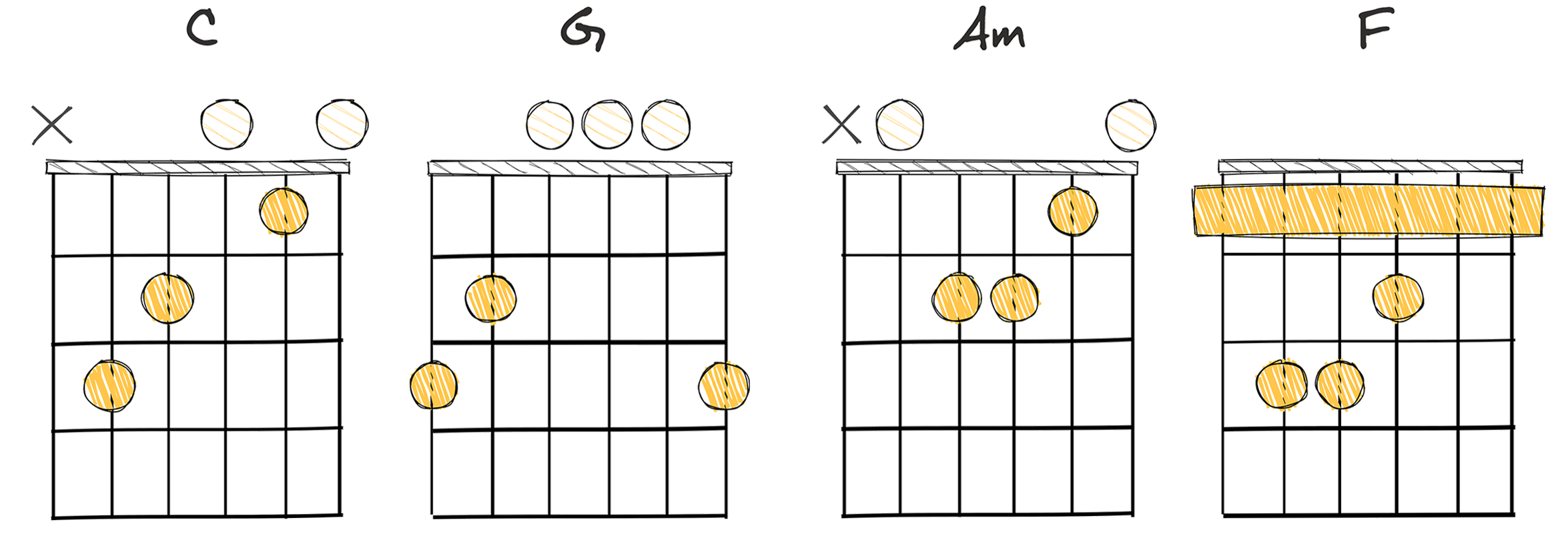
The chord progression I-V-vi-IV (1-5-6-4) in the Key of C Major translates to C – G – Am – F.
This progression is a classic staple in the realm of music, particularly in EDM, employed extensively due to its simpleness and versatility.
One intriguing facet of this progression is its ease of play.
For a novice producer or musician, it offers accessibility and a great starting point for orchestrating a compelling harmony.
While the progression’s simplicity might make it feel basic, the beautiful thing is how versatile I-V-vi-IV truly is.
The above statement multiplies when we do a historical survey of the I-V-vi-IV progression.
This chord sequence found its way into the fabric of all music, from pop and rock to classical and, of course, Electronic Dance Music (EDM).
Invoking this progression affords the aspiring producer the ability to inject a recognizable sense of resonance and familiarity into their works.
That’s no small consideration when finding your footing in the competitive music industry.
An aspiring EDM producer would be wise to note how frequently this progression crops up within the genre and its sub-genres.
The EDM spectrum, from its more mainstream facets to the deep, melodic corners, readily employs this progression.
It’s an enduring testament to the I-V-vi-IV progression’s sheer compatibility with electronic music’s pulse-driven nature.
Therefore, in mastering this progression as an EDM producer, you’re familiarizing yourself with a reliable tool that’s been tested and proven across generations of brilliant music.
In your explorations, you’ll begin to understand the nuances of the I-V-vi-IV progression.
You will appreciate the creative adaptability it offers, which can help shape your unique sound as an EDM producer.
Highlighted examples, lessons, and the breadth of the music crafted around them are just the tip of the iceberg.
As you delve into this fundamental progression, you’ll unearth that the I-V-vi-IV progression is more than just an accessible entry point into music production.
It’s a creative springboard to an endless ocean of harmonic possibilities.
The I-V-vi-IV progression can not only help shape the skeleton of a song but also provide the essential muscle and sinew to take it from a novice product to a resonating masterpiece.
ii-V-I (2-5-1)
The backbone of electronic music, linking chords seamlessly.
The ii-V-I chord progression is a fundamental sequence in music theory, commonly found in a wide spectrum of genres including electronic dance music (EDM). Its cyclical nature makes it perfect for establishing a melodically satisfying loop, making it an indispensable tool for any aspiring EDM producer.
- Difficulty: Easy
- Example: Dm – G – C (Key of C major)
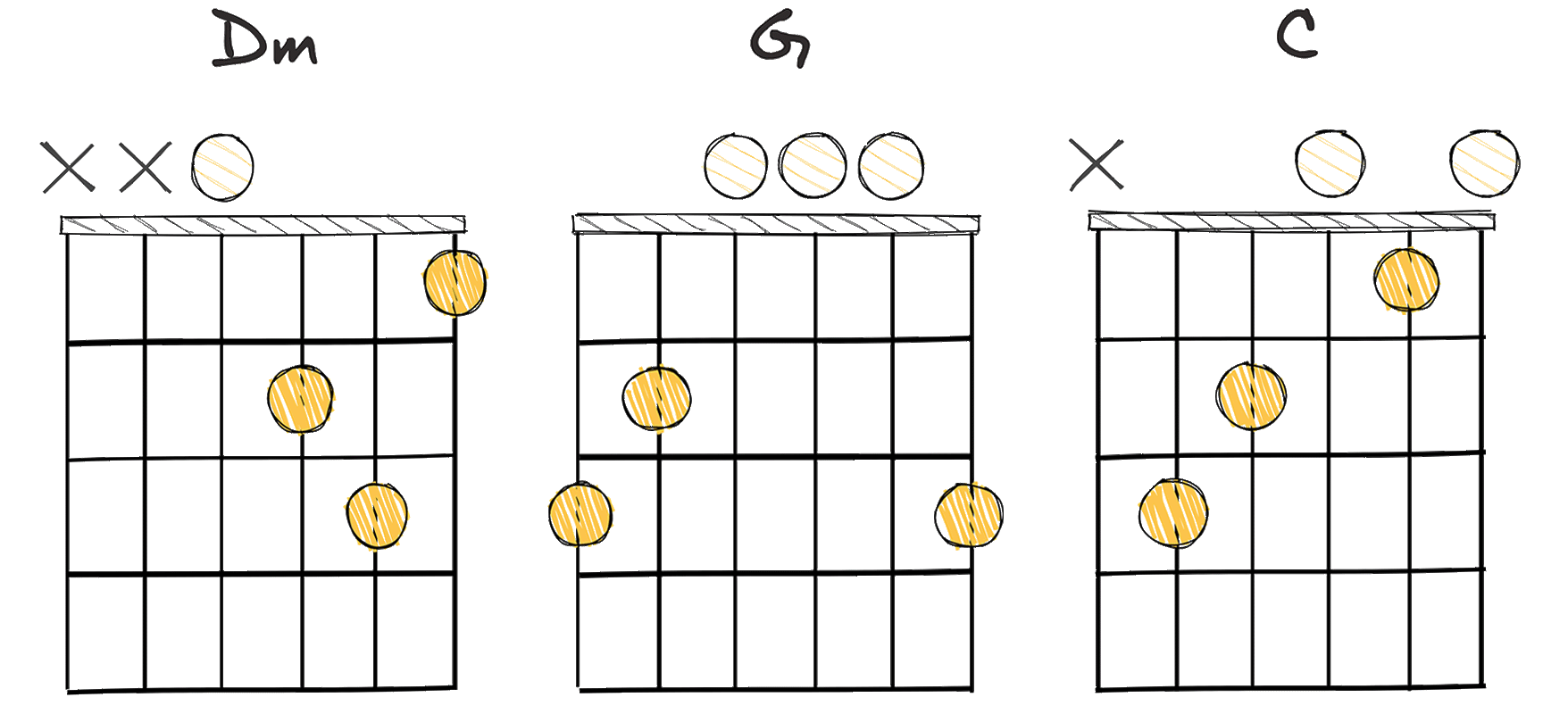
The chord progression ii-V-I is one of the most utilized sequences in many music genres, including Electronic Dance Music (EDM).
It has an especially rich history in the realm of jazz, where it came to define much of the conventional harmony.
Its prevalence can be attributed to its tendency to generate tension through the V chord (the dominant), which is subsequently resolved by the I chord (the tonic).
This tension and release have a harmonic pull that makes songs sound complete and satisfying to the listener.
As a consequence of its jazz roots, the ii-V-I progression has a less straightforward sound which may contribute to a more complex, nuanced dynamic in your EDM production.
When considering the dynamics of ease in playing this chord progression, it is generally considered easy to play, particularly on piano or keyboard.
The simplicity of playing the ii-V-I chord progression lends an ease to producers, allowing them to focus more on creativity in their sound design and melodies, rather than mastering complex chord trends.
The ii-V-I progression encourages a seamless flow of creativity, offering a solid, reliable base for melodic exploration and complexity.
Therefore, it can be an excellent starting point for novice producers or a powerful tool for seasoned EDM professionals.
The chord progression typically used in the key of C major is Dm – G – C.
In terms of contemporary application, the ii-V-I progression can be heard in numerous popular tracks.
Essentially, mastering this chord progression can indeed be the secret to creating compelling, emotionally resonant EDM tracks that connect with listeners on a deeper level.
V-vii°-iii-IV (5-7-3-4)
This progression is the powerhouse that fuels pop-infused EDM tracks.
The V-vii°-iii-IV progression in G major, with chords D – F#dim – Bm – C, creates an enticing sonic journey. The sequence opens with a bold majesty, flows into mysterious tension, eases into reflective calm, and resolves with warmth. It’s a brief yet captivating dance of chords that combines intrigue and beauty, resonating with listeners through its unique blend of emotions.
- Difficulty: Easy
- Example: D – F#dim – Bm – C (Key of G major)
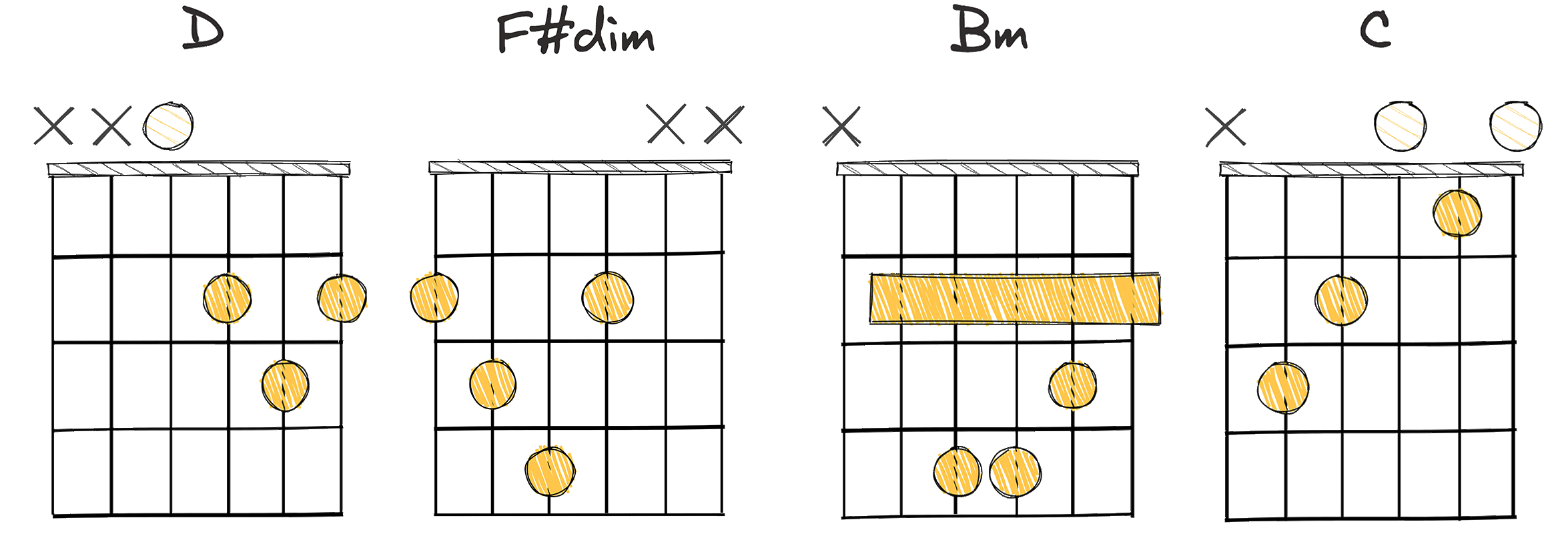
Starting our journey into the V-vii°-iii-IV (5-7-3-4) chord progression, we first recognize that this sequence is a remarkable constellation of chords that weaves itself through a variety of musical landscapes, not the least of which is classical compositions.
Take, for instance, the D – F#dim – Bm – C progression in the key of G major. It’s a melody-maker’s dream, and there’s something enchanting about the way these chords dance together.
Historically, this progression finds its roots in the diatonic chords of the major scale, painting a rich tapestry that has been utilized by composers for centuries.
It’s sometimes referenced as the ‘classical crossover,’ echoing its resonance with both traditional and contemporary music.
What makes the V-vii°-iii-IV progression stand out is its sophisticated blend of tension and resolution, a dance of chords that can captivate the soul and engage the mind.
The ‘V-vii°-iii-IV’ progression creates a musical journey, navigating through emotional landscapes and captivating listeners with its elegant complexity.
Diving deeper, it’s this very complexity and refinement of the ‘V-vii°-iii-IV’ that turns musical notes into sonic artistry.
The resulting auditory tapestry can be as dramatic or as subtle as the composer desires, illuminating various emotions ranging from joy to sorrow, longing to satisfaction.
As an aspiring musician honing your craft, mastering this specific chord progression can open doors to a world of creativity and expression.
You will find yourself weaving intricate melodies and spellbinding harmonies, adding a rich layer of depth to your musical creations.
With diligent practice, the ‘V-vii°-iii-IV’ becomes more than a sequence of chords; it becomes a musical storyteller, ready to narrate whatever tale your heart wishes to tell.
Remember, the brilliance of music resides in its boundless creativity and the opportunity to explore and innovate, even within time-honored chord progressions.
As an ambitious composer, embracing the potential of the V-vii°-iii-IV chord progression could be your pathway to crafting pieces that resonate deeply, linger in memory, and stand as timeless reflections of musical artistry.
I-vi-IV-V (1-6-4-5)
A timeless progression imbuing melodies with profound, emotional depth.
The I-vi-IV-V chord progression, also known as 1-6-4-5, is a classic and common progression used extensively in various styles of music, especially in electronic dance music (EDM). With its signature emotive and stirring tonal movement, it forms the melodic foundation of many memorable tracks, making it a fundamental tool for any aspiring EDM producer.
- Difficulty: Easy
- Example: G – Em – C – D (Key of G major)
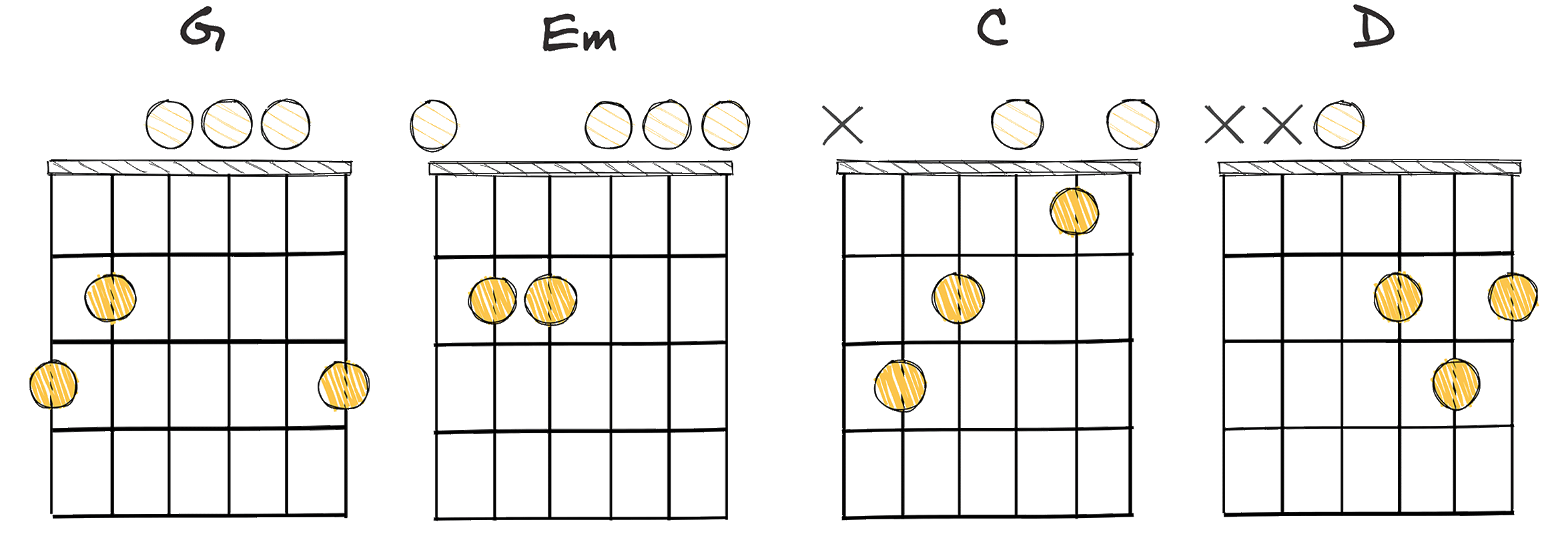
As a discerning aspiring EDM producer, mastering essential chord progressions is quite significant in the crafting of harmonious and engaging tracks.
One such essential progression is the I-vi-IV-V (1-6-4-5) chord progression.
This is one of the simpler chord progressions used in the EDM genre, especially appealing to fresh producers due to its ease of play and compatibility with a variety of song structures and musical styles.
Implementing the I-vi-IV-V progression effectively in your production states a strong understanding of harmony and melody.
The simplicity of the I-vi-IV-V progression provides a melodically rich and engaging platform for creating dynamic, catchy EDM tracks.
Every EDM producer should strive to master the I-vi-IV-V progression due to its adeptness at showcasing lush harmonies and stimulating melodies.
This progression allows for lively harmonic movements that play a crucial role in establishing the emotional core of songs and enhancing the overall listening experience.
Historical use of the I-vi-IV-V progression in classic pop and rock music, further lends its versatility in its application in EDM tracks.
Although easy to play, the I-vi-IV-V progression requires a profound understanding of harmony and melodic structure to bring out its full potential in EDM production.
By properly employing the I-vi-IV-V progression, you will ensure that your EDM tracks possess a strong harmonic core, stimulate emotional responses, and resonate with your audience on a profound level.
Therefore, for any aspiring EDM producer, mastering the I-vi-IV-V progression is every bit as essential as mastering the craft of music production itself.
I-IV-V (1-4-5)
The cornerstone of countless EDM tracks, delivering catchy, pop-inspired hooks.
The I-IV-V chord progression is considered a pillar in the field of electronic dance music (EDM) due to its simplicity and adaptability. It carries a strong resolution and is often used in danceable rhythms, forming the fundamental structure of many popular EDM tracks.
- Difficulty: Easy
- Example: G – C – D (Key of G major)
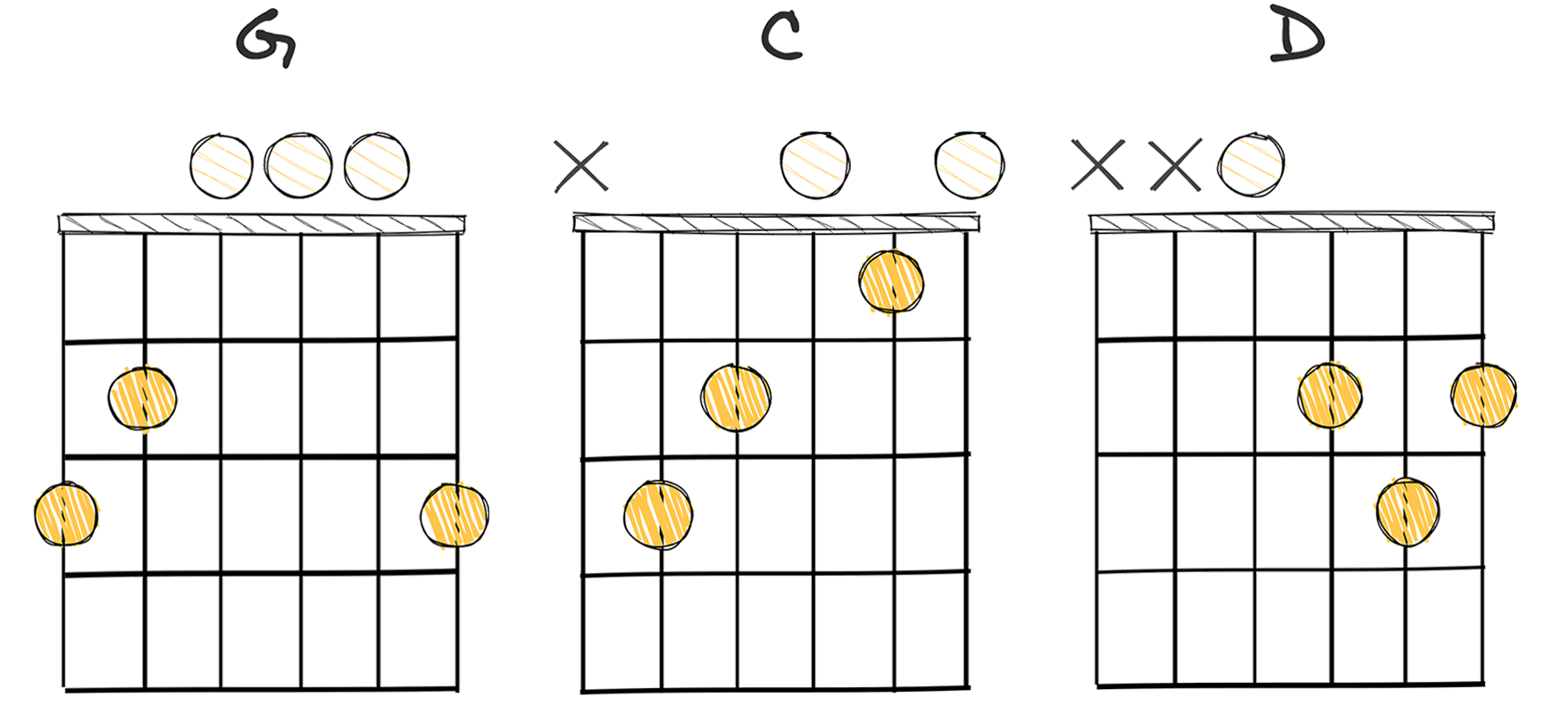
The I-IV-V chord progression is one of the most well-known and frequently used progressions in the music world and is especially prevalent in EDM (Electronic Dance Music).
Historically, the I-IV-V progression traces its origins back to the classical era and has been a staple in popular music genres for centuries.
Typically, this progression utilizes the root, fourth, and fifth notes of the major scale, creating a harmonious and pleasing sound to the ears.
Enthusiasts assert that the I-IV-V progression is particularly suitable for beginners due to its simplicity and the ease with which it can be played on any musical instrument.
The EDM genre, in particular, is known for its ability to create vibrant and energetic melodies, and the I-IV-V progression fits seamlessly due to its inherently upbeat nature.
This chord progression can be utilized to induce a variety of moods in EDM, from an upbeat, vibrant track suitable for a festive dance floor, to a more soothing, laid-back piece.
It’s versatility extends to its ability to blend well with other chord progressions, offering a rich tapestry of sound that adds depth and complexity to the music.
In the context of EDM, the interplay of sounds produced by the I-IV-V progression align perfectly with the rhythm and beat, creating an infectious parade of notes that leave the listener entranced.
Sticking to the key of G Major, we see that the chords G (I), C (IV), and D (V) create the I-IV-V progression.
These chords, when played sequentially, give a pleasing harmonic progression that is often repeated throughout an EDM track.
Countless popular EDM tracks use this progression as it provides a strong melodic base and allows for substantial creative freedom for producers.
Whether Uplifting, Techno or Deep House, the I-IV-V progression can be manipulated to fit each sub-genre’s unique style, offering an immense scope for innovation.
iii-vii°-ii-V (3-7-2-5)
An intriguing musical journey, moving from introspective tension to contemplative grounding, and concluding with a triumphant resolution, all in a single harmonious flow.
The iii-vii°-ii-V progression in C major, using the chords Em – Bdim – Dm – G, weaves a musical narrative that transitions from introspection to uncertainty, then flows into contemplation before concluding with triumph. This sequence’s blend of tension and resolution forms a captivating harmony, resonating with listeners in a succinct yet profound way.
- Difficulty: Easy
- Example: Em – Bdim – Dm – G (Key of C major)
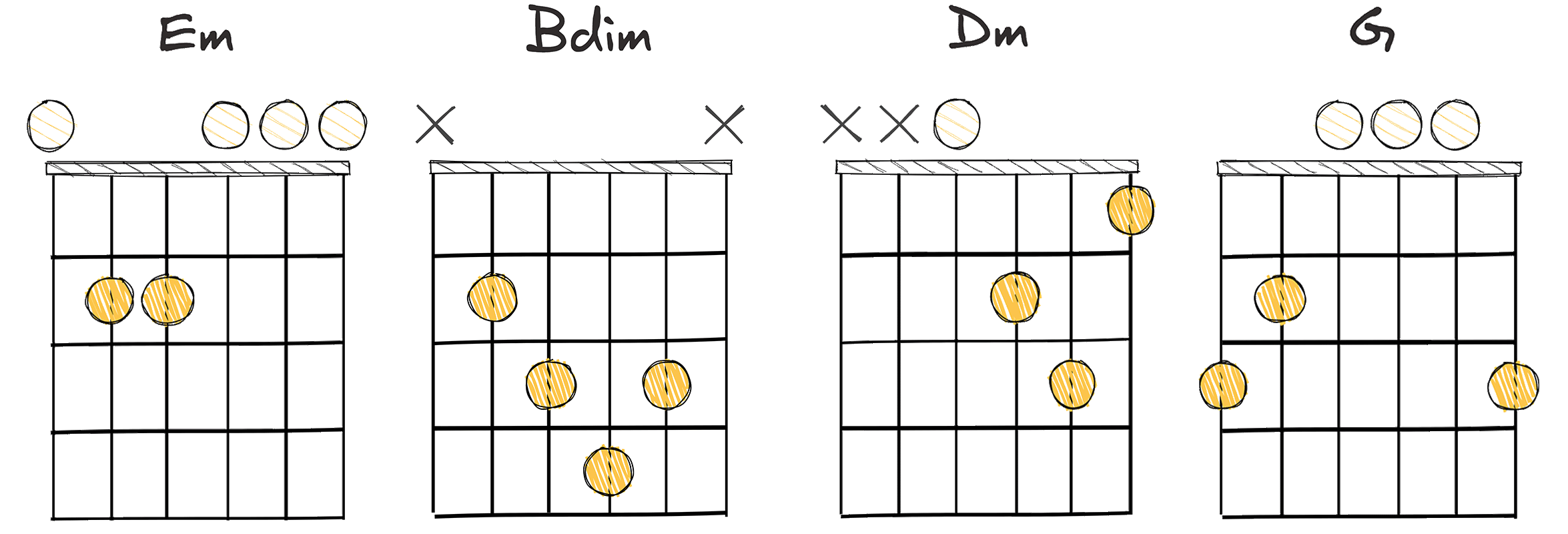
The iii-vii°-ii-V (3-7-2-5) chord progression, while having roots in classical and jazz traditions, has a timeless quality that resonates with contemporary musicians and music enthusiasts alike.
This chord progression, with origins that can be traced back to jazz’s golden era, has carved its unique niche in various music forms, not excluding the innovative sphere of Electronic Dance Music (EDM).
Although the progression may appear more complex on paper, its emotional depth and harmonic richness offer an intriguing sonic texture that’s both challenging and rewarding to explore.
The iii-vii°-ii-V chord progression fits seamlessly into EDM because it provides a nuanced balance of tension and resolution, lending itself to create those thrilling highs and reflective lows that are a hallmark of the genre.
Moreover, the sophistication of this chord progression allows for creativity and exploration, as it can be used to craft everything from melancholic ballads to pulse-pounding dance anthems.
For instance, it can articulate a hauntingly beautiful melody when paired with soft synth pads, or induce a powerful surge of energy when driven by relentless beats and aggressive synth leads.
In the realm of EDM, this progression opens doors to creative experimentation, enabling producers to engineer tracks that connect with listeners on a profound level while preserving the genre’s essential rhythmic vitality.
When incorporating this progression into an EDM composition, producers have the freedom to play with different instrumental textures, rhythmic complexities, and sonic layers to create a piece that’s uniquely engaging.
In the C Major Key, the respective chords for the iii-vii°-ii-V progression are Em – Bdim – Dm – G.
Thus, embracing the iii-vii°-ii-V chord progression provides modern producers, including those in the EDM world, with a musically rich and expressively versatile palette that can be wielded to produce compositions that not only move the feet but also stir the soul.
ii-IV-V (2-4-5)
This progression adds an unexpected twist to traditional EDM harmony.
The ii-IV-V (2-4-5) progression is a powerhouse in electronic dance music production, often used for its high-energy and strong resolution. This progression creates a tension build-up from the second chord (ii) leading seamlessly towards a climactic resolution at the fifth chord (V), making it perfect for creating dramatic and exciting EDM tracks.
- Difficulty: Easy
- Example: Em – G – A (Key of D major)
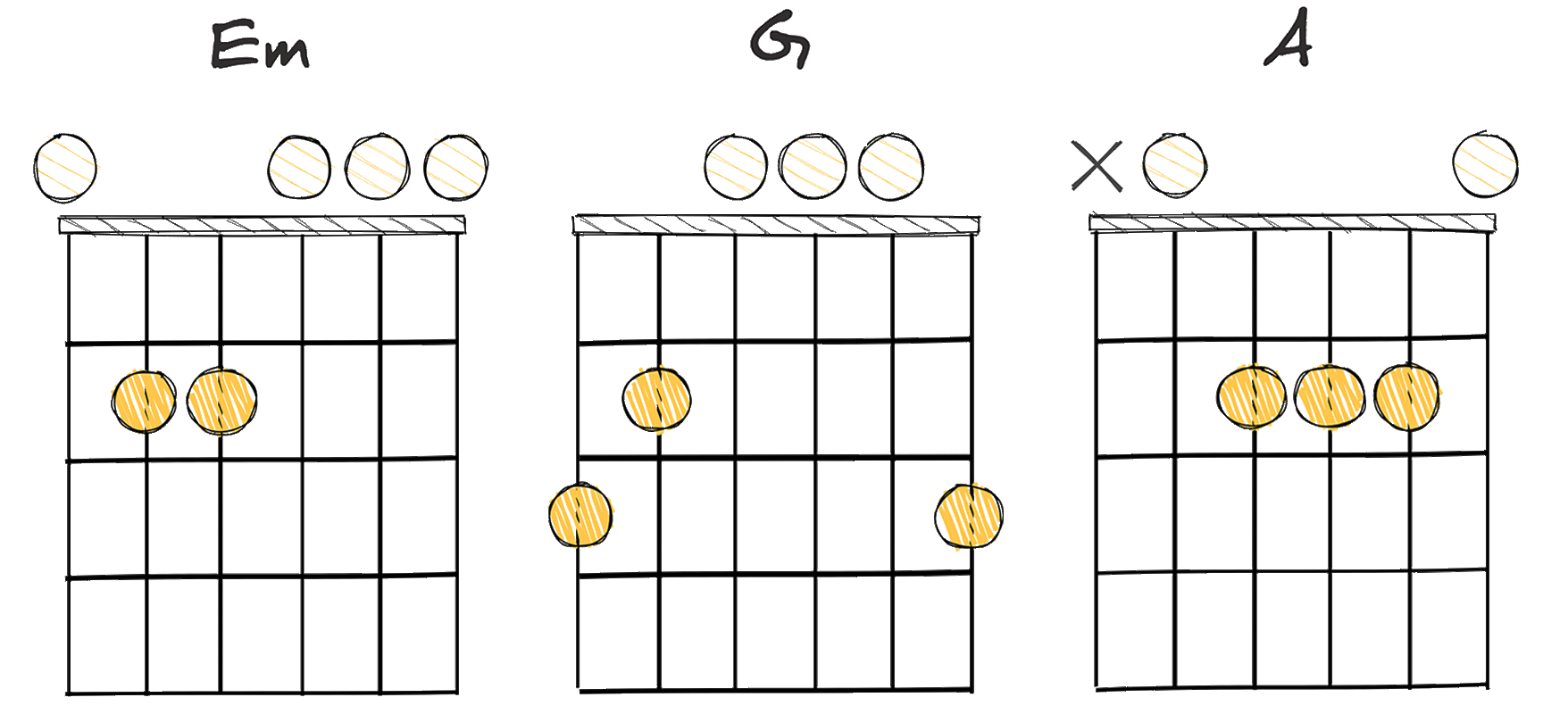
The ii-IV-V (2-4-5) chord progression is yet another essential progression in Electronic Dance Music (EDM) that every aspiring producer should endeavor to utilize and master.
This progression is simple yet very intricate to craft seamlessly.
However, due to its simplicity, it comes out as very easy to play in terms of keyboard chording or guitar strumming.
Characteristically, the ii-IV-V progression produces an exciting, uplifting tone which is a staple in the EDM genre.
This makes it a perfect chord list for creating melodically rich dance music tracks that revolve around positive, high-energy themes.
Interestingly, this progression has seen substantial application in the pop music industry, making its transition to EDM rather smooth and organic.
Unrepresentatively and taking a sneak into the “real world”, the ii-IV-V progression in the key of D major would be notated as Em – G – A.
This gives an acute perspective on how these chords work harmoniously, to achieve a feel-good, dance-floor-ready tune.
By essence, the ii-IV-V progression offers a remarkable progression formula that steers EDM productions towards vibrancy and catchiness.
It further unlocks a broad array of melodic options to explore, fostering the creation of unique, immersive effects.
Therefore, mastering it not only provides you with a powerful melodic tool but also sets you on a path of inventiveness and uniqueness in your music production journey.
I-vii°-IV-iii (1-7-4-3)
An unique sonic path, blending confidence, tension, warmth, and introspection into a harmonious journey.
The I-vii°-IV-iii progression in D major, consisting of the chords D – C#dim – G – F#m, paints a rich and captivating auditory picture. Beginning with the confident and bold D major, it takes an unexpected turn into the enigmatic C# diminished, creating a suspenseful tension. This is then gracefully resolved into the warm and embracing G major, before settling into the reflective and thoughtful F# minor chord. Together, these chords form a melodious journey that’s both complex and emotionally stirring..
- Difficulty: Intermediate
- Example: D – C#dim – G – F#m (Key of D major)
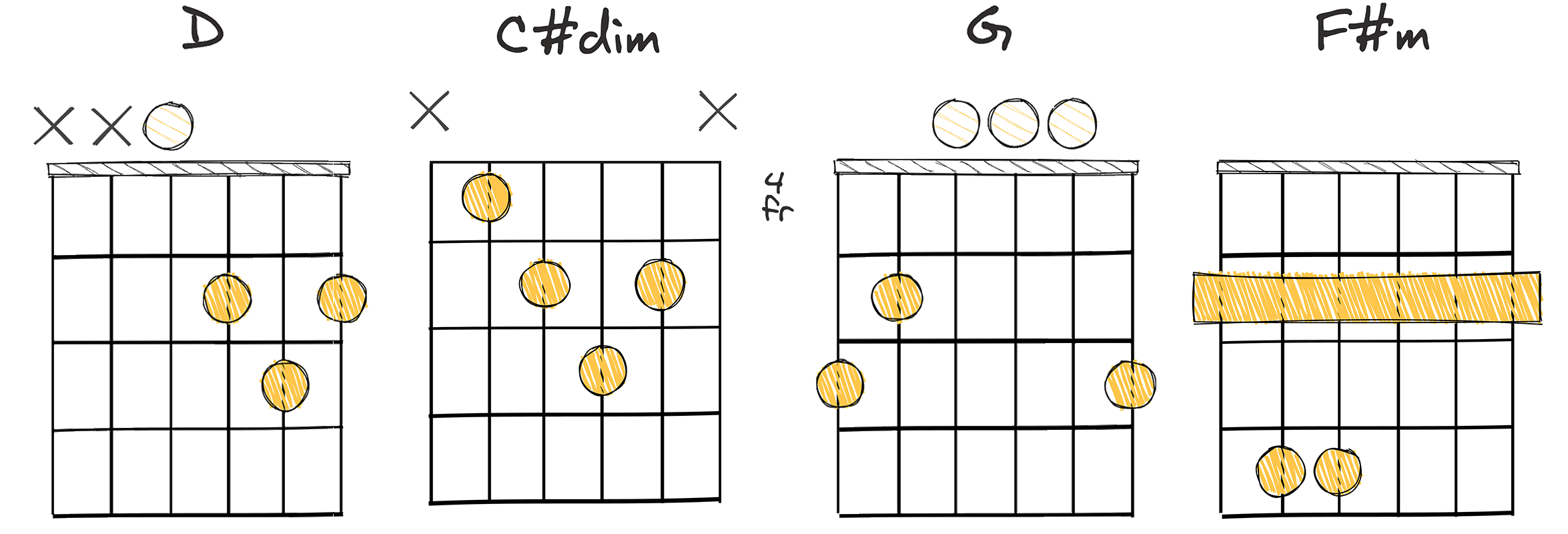
The I-vii°-IV-iii chord progression, notated as 1-7-4-3 in roman numerals, stands as a valuable musical sequence that contemporary musicians and producers, especially in EDM, can draw upon for inspiration and creativity.
Somewhat more complex yet highly rewarding, this progression has an alluring musical depth, bringing together chords that form a captivating blend of sound and emotion in electronic dance music production.
This progression is structured around four chords, weaving a path that leads listeners through a series of unique tonal experiences.
It commences with the major I (1) chord, then moves to the mysterious and tense vii° (7) diminished chord, followed by the full-bodied and anchoring IV (4) major chord, and concludes with the reflective iii (3) minor chord.
This sequence of chords creates an emotional journey, with the progression from the assertive D major chord into the tense C# diminished, then blossoming into the comforting G major chord, and finally settling into the reflective F# minor chord.
In the Key of D major, this chord progression would consist of the chords D – C#dim – G – F#m.
The progression’s shifts and transitions craft a vibrant tonal landscape that smoothly evolves from strength to tension to warmth, culminating in introspective contemplation.
The I-vii°-IV-iii progression, although not as common as some other progressions, holds a special place in various musical genres, including jazz, classical, and contemporary EDM.
Its appeal lies in its ability to convey complex emotions and moods, offering a rich foundation upon which musicians can build their melodies and harmonies.
In the context of an EDM composition, this chord progression provides a sophisticated harmonic base, enabling producers to experiment with intricate melodies and innovative rhythmic patterns.
The interplay and balance within these chords create a wellspring of musical possibilities, making the I-vii°-IV-iii progression a stimulating and versatile tool for those looking to craft music that resonates deeply and transcends conventional boundaries.
vii°-iii-vi-V (7-3-6-5)
The vii°-iii-vi-V progression serves as the emotional powerhouse in EDM.
The vii°-iii-vi-V chord progression is a fundamental sequence in EDM, used for its highly uplifting and satisfying resolution. Aspiring producers should master this progression as it provides a solid foundation for many tracks, creating an engaging mix of peace and tension that keeps listeners hooked.
- Difficulty: Advanced
- Example: D#dim – G#m – C#m – B (Key of E Major)
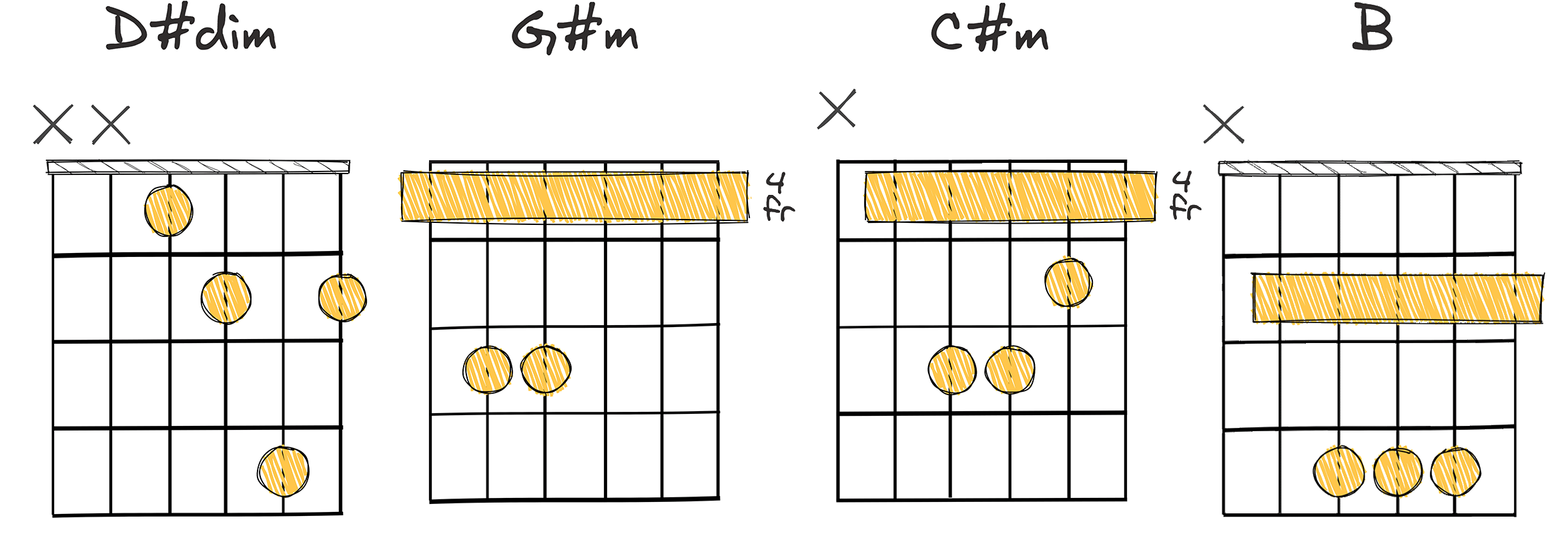
The vii°-iii-vi-V (7-3-6-5) chord progression, manifested through the chords D#dim – G#m – C#m – B in the key of E major, stands as a remarkable and impactful progression that invites both novice and experienced musicians to explore.
Originating from a rich musical history, this progression exhibits a distinct charm and complexity, marking its place in various genres, from classical orchestration to contemporary electronic dance music (EDM).
The chords D#dim – G#m – C#m – B form a progression that is not only intriguing to the ears but also provides a fascinating playing experience.
The shift from the diminished chord into minor chords followed by a dominant major adds to the complexity and allure of this sequence.
This progression serves as a fruitful platform for delving into intricate fingering techniques, harmonic structures, and compositional creativity.
Its uniqueness and adaptability make it an effective tool for producing enticing melodies and innovative musical textures.
Many EDM producers are drawn to the vii°-iii-vi-V progression for its ability to generate memorable musical experiences and its compatibility with various EDM styles.
Its musical structure resonates with listeners, creating an emotional connection and ease of recognition, thus enhancing the overall impact of a song.
Incorporating the vii°-iii-vi-V progression into your musical repertoire can foster dynamic and engaging harmonies, opening doors to creative experimentation and exploration.
From a production perspective, the adaptability and diversity of this progression enrich its applicability across genres, making it a resonant link between the traditional and modern musical landscape.
The vii°-iii-vi-V progression transcends musical boundaries and continues to inspire producers in shaping emotive and compelling compositions.
Its nuanced sound profile and harmonic richness can elevate a producer’s toolkit, guiding them in crafting tracks that resonate deeply with audiences.
Mastering this progression can significantly enhance the emotional depth, creativity, and overall quality of your music, whether in classical compositions or the pulsating beats of EDM.
I-ii-IV-V (1-2-4-5)
A joyous, uplifting chord progression staple in electronic dance music.
The I-ii-IV-V (1-2-4-5) progression is a fundamental chord pattern often used in electronic dance music (EDM) production. It is known for its uplifting and energetic sound, which typically serves as the backbone of many dance tracks, driving the rhythm and melody forward.
- Difficulty: Easy
- Example: G – Am – C – D (Key of G major)
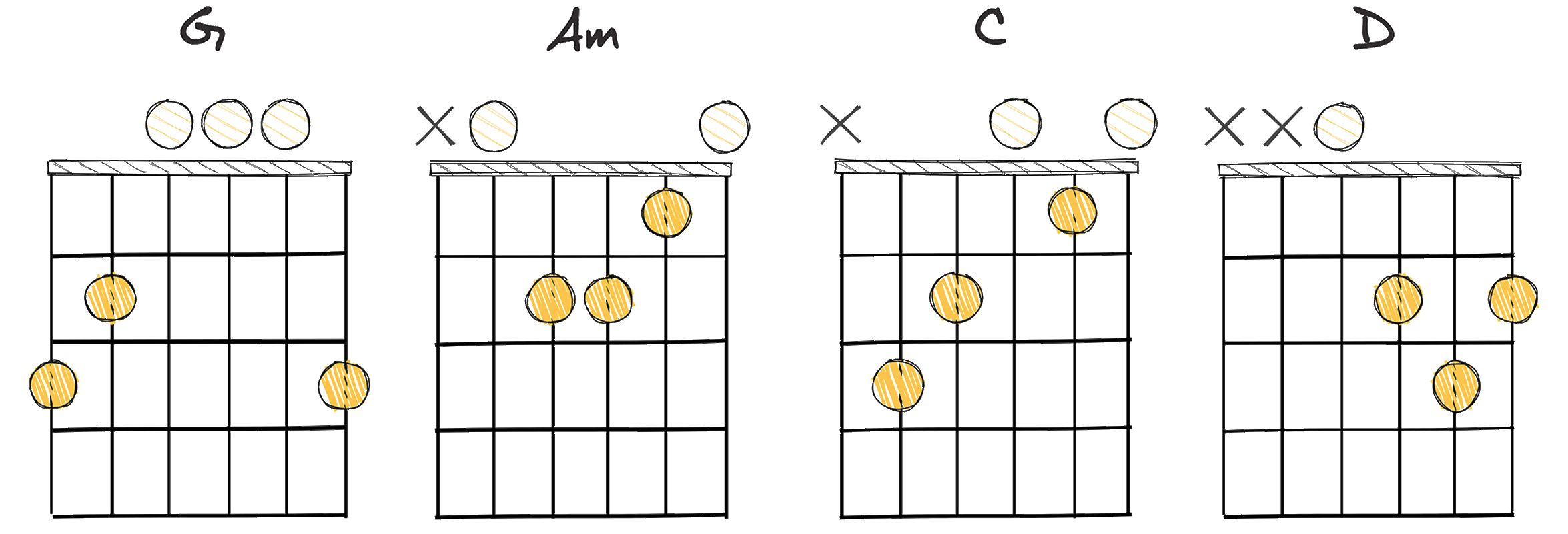
The chord progression I-ii-IV-V, represented numerically as 1-2-4-5, is a key tool for any budding electronic dance music (EDM) producer to have in their arsenal.
Though seeming simple at a glance, this seamless shift from tonic (I), the supertonic (ii), the subdominant (IV), and to the dominant (V), packs a unique auditory punch that serves to invigorate and captivate the listener.
Remember, simplicity in music production does not equate to mundanity; instead, it paves the way for transformative creativity, a cornerstone in the world of EDM.
Tracing its roots back to the origins of classical music, the I-ii-IV-V progression presents a wonderful point of exploration for the creative mind in establishing its own EDM track.
This timeless progression sparks intrigue due to its rich historical grounding, having featured primarily in classical music before making its way into pop, rock, and now EDM.
Resorting to this tried-and-true progression offers an assured quality and familiarity to your track, increasing the chances of broadly appealing to listeners.
Assuming the progression is easy to play, EDM producers can quickly learn, experiment, and create unique sounds around the I-ii-IV-V progression.
Notably, the I-ii-IV-V progression can be seen in the key of G major, where it translates to G – Am – C – D.
And in this instance, the chords resonate with a distinctive tonal charm unique to the key of G major.
For example, the song ‘Life is a Highway’ by Tom Cochrane uses these chords and falls into the I-ii-IV-V progression in the key of G major – a further testament to the progression’s versatility spanning multiple music genres, including EDM.
As an EDM producer, it’s critical to tap into the emotional essence embedded within each chord in the I-ii-IV-V progression.
The possibility of evoking diverse emotions within this progression is indeed vast.
vi-vii°-IV-V (6-7-4-5)
This progression adds suspenseful rise and satisfying resolution in EDM.
The vi-vii°-IV-V progression is a well-utilized sequence in EDM that can add spirited tones and transitions to your compositions. It warrants attention for the remarkable dynamism it brings to music, with the capacity to create an uplifting crescendo, making it a beloved tool among many EDM producers.
- Difficulty: Advanced
- Example: Bm – C#dim – G – A (Key of D major)
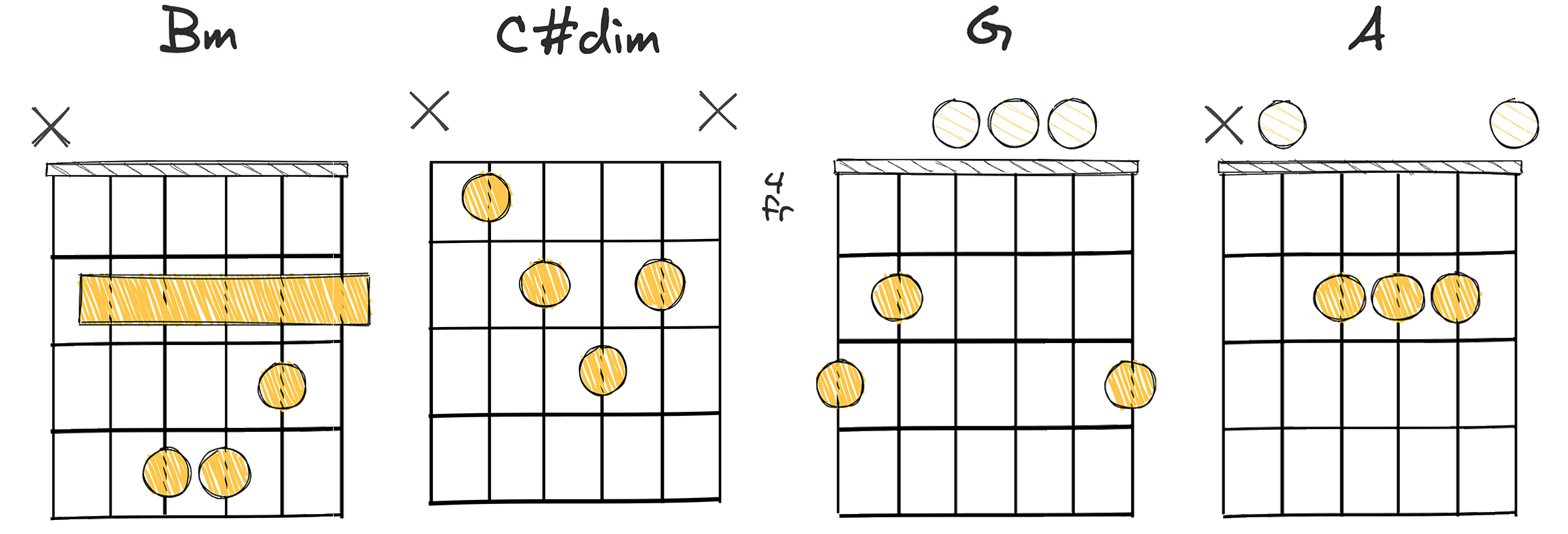
Continuing the exploration of essential EDM chord progressions, we now arrive at the vi-vii°-IV-V (6-7-4-5) progression.
This intriguing arrangement of chords has a long and storied history in the realm of electronic dance music production.
A staple that aspirants should truly master, this progression has been used in countless anthems and dance floor hits.
This chord progression is rather straightforward and easy to play, making it a favourite amongst new and seasoned EDM producers.
Instead of complex chord switches, producers can focus on the emotion that the progression evokes.
Its simplicity can potentially speed up your creative process and allow you to concentrate on innovation within other aspects of your production.
Moreover, understanding this progression offers a sound basis for improvisation.
A careful tweak here and there can lead to an endless variety of rhythmic and melodic combinations.
This particular progression features an interesting jump from vi to vii before gliding down to IV and V.
For instance, Bm – C#dim – G – A in the key of D major climbs up from Bm to C#dim before falling to G and A.
This sort of pattern gives the progression a distinctive, distinctive melodic movement.
Moreover, the movement felt in this progression is a key aspect of its emotional impact.
Many EDM anthems have used this progression to create a sense of tension and release that listeners can’t resist.
Additionally, EDM producers often use this progression for its versatility.
No matter the texture, tempo, or style of your track, the vi-vii°-IV-V progression can easily fit and enrich the overall production.
The final chord, V, often acts as a conduit to effortlessly loop back to the start of the progression or lead into a different part of the composition.
This provides a great deal of flexibility when structuring your track.
Interestingly, this chord progression’s ease of use does not diminish its effectiveness over time.
Even after a plethora of use in many EDM chart toppers, it still offers a fresh canvas to write captivating melodies.
I-iii-vi-ii (1-3-6-2)
A remarkable combination that transcends time
The I-iii-vi-ii progression (C – Em – Am – Dm in the key of C major) creates a reflective and contemplative mood, weaving between the stability of the major chords and the introspective feel of the minor ones. Its thoughtful sequence can resonate with listeners, offering a gentle complexity that invites emotional exploration.
- Difficulty: Easy
- Example: C – Em – Am – Dm (Key of C major)
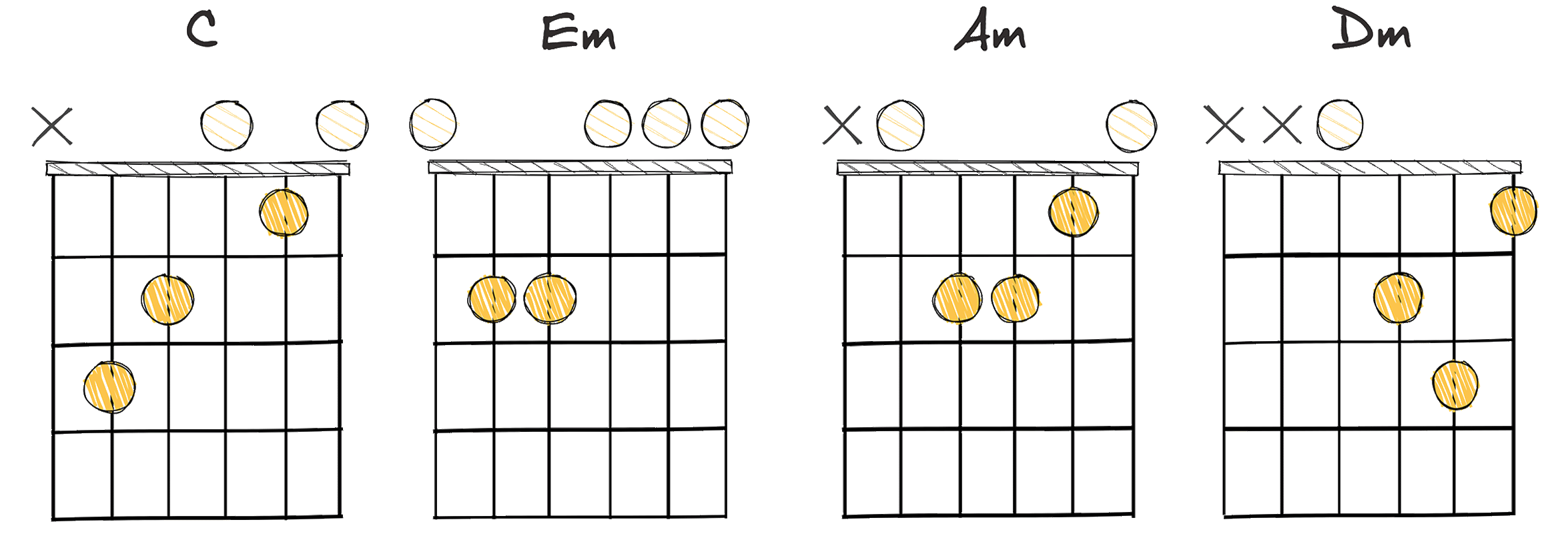
The I-iii-vi-ii chord progression, notated as 1-3-6-2 in roman numerals, is an enriching sequence that resonates deeply within various music genres, including EDM.
This progression, known as I-iii-vi-ii, is a remarkable combination that transcends time, having been embraced by classical composers and modern EDM producers alike.
Its engaging nature, with its smooth flow and emotionally captivating sequence, has made it a favorite among musicians.
Woven into numerous electronic music sub-genres, from techno to ambient to progressive, the I-iii-vi-ii progression’s allure lies in its melodic grace.
It’s a progression that invites the musician to play with ease, offering harmonic richness and complexity.
The chord progression I-iii-vi-ii (C – Em – Am – Dm in the key of C major) flows naturally on a variety of instruments, making it accessible for electronic music producers, whether they’re working on keyboards or cutting-edge digital tools.
As it unfolds, the transition from the I (tonic) chord to the iii (mediant) chord builds a gentle intrigue, flowing into the melancholic vi (submediant) chord, and culminating in the thoughtful ii (supertonic) chord.
This progression can be perceived as a musical journey, leading the listener through a range of emotions, settling into a poignant resolution, providing both familiarity and a touch of mystery.
The inherent balance within the I-iii-vi-ii progression allows creative minds to innovate with textures, rhythms, and sounds without losing the core essence of the melody.
Bridging the gap between time-honored musical traditions and contemporary electronic sounds, understanding and mastering the I-iii-vi-ii progression can unlock a world of creativity and expression for EDM producers, contributing to their unique musical narrative.
I-iii-IV-V (1-3-4-5)
Elevating mood by stepping out of traditional harmonic expectations.
The I-iii-IV-V chord progression is an important structure often used in Electronic Dance Music (EDM) that offers a feel of both tension and resolution. Aspiring EDM producers must master this progression as it aids in establishing a melodic foundation, often creating an upbeat and energetic vibe, characteristic of the genre.
- Difficulty: Intermediate
- Example: G – Bm – C – D (Key of G major)
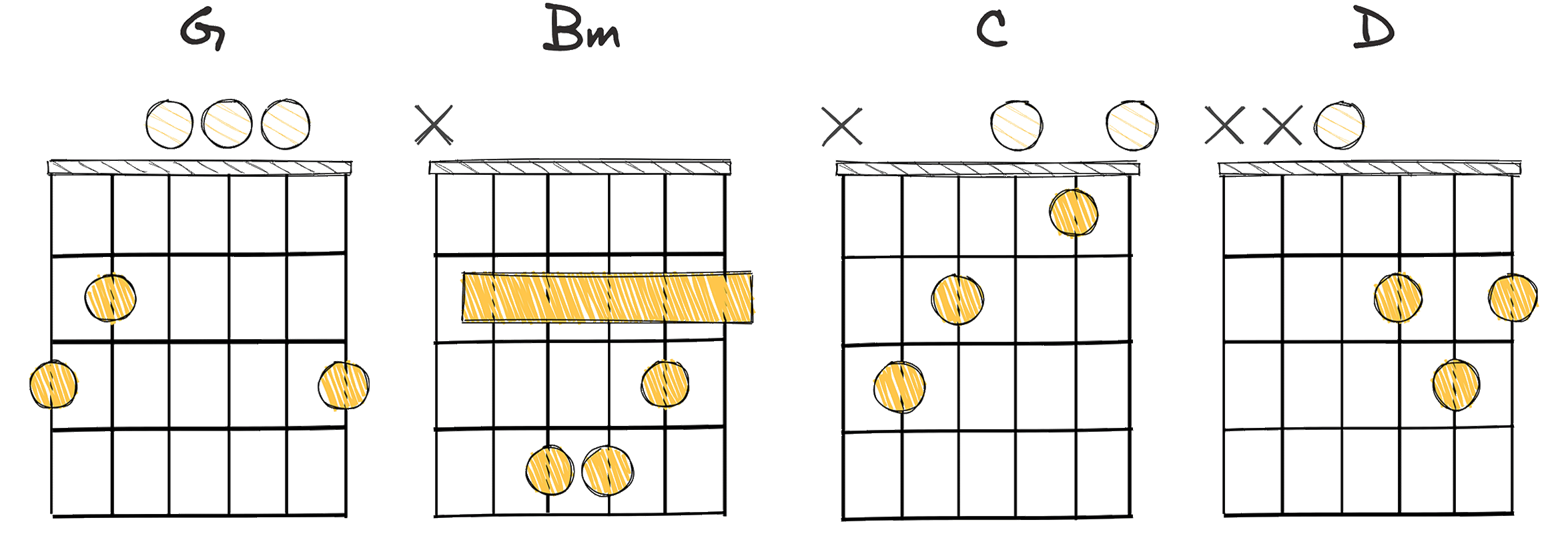
The I-iii-IV-V chord progression is simply another essential tool in the toolbox of any aspiring producer, particularly those working in the realm of Electronic Dance Music (EDM).
This four-part progression provides a pleasant, upbeat feeling typically associated with pop music and is especially prominent in many uplifting EDM tracks.
In the key of G major, for example, this progression would play out as G – Bm – C – D, translating to a sequence of I-iii-IV-V.
When you play these chords in this order, you will notice a naturally harmonious resonance.
The combination manages to maintain both a sense of forward momentum and a satisfying return to the tonic, or root, chord, which in this case would be G major.
Historically, the I-iii-IV-V progression is a traditional staple dating back to the roots of Western music.
It is a progression that has been adopted and adapted in countless genres and sub-genres over the centuries, and EDM is no different in utilizing this versatile sequence.
As such, understanding and mastering the I-iii-IV-V progression can be an invaluable asset to any aspiring EDM producer, offering a solid foundation from where they can build and experiment with their own unique sounds.
Even though I-iii-IV-V may seem straightforward, the potential for innovation and creativity within this chord progression is immense, with endless possibilities for arrangement and instrumentation.
Indeed, the simplicity of I-iii-IV-V is part of its strength, rendering it easy to play and manipulate for producers while still being capable of delivering powerfully emotive music.
Therefore, I-iii-IV-V is just as vital among the essential EDM chord progressions that every aspiring producer needs to master, offering an effective and versatile framework for creating captivating EDM tracks.
Whether you’re a seasoned EDM producer or just starting out in the genre, experiment with different tones and textures in I-iii-IV-V chord progression, and you may discover new ways of delivering evocative sounds in each of your compositions.
vi-V-IV (6-5-4)
An emotive progression, 6-5-4 creates a melancholic, youthful EDM vibe.
The vi-V-IV progression, also known as the 6-5-4 progression, is integral to Electronic Dance Music (EDM) production, often lending the genre its signature energetic and uplifting sound. This progression typically starts from a minor chord and gradually builds up to a perfect major chord, adding a level of tension and release that resonates strongly within EDM tracks.
- Difficulty: Easy
- Example: F#m – E – D (Key of A major)
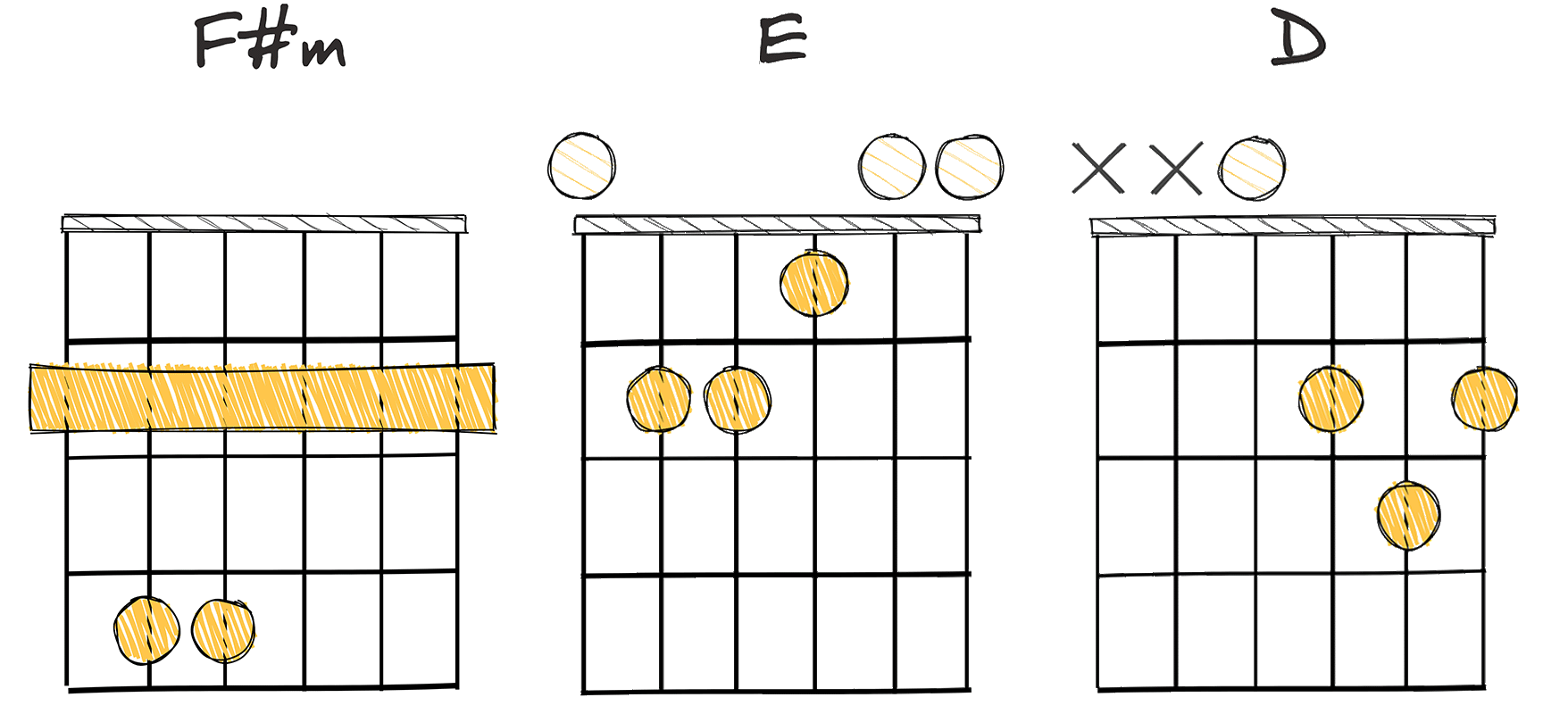
In the world of Electronic Dance Music (EDM), the chord progression vi-V-IV (6-5-4) holds a significant place.
Irrespective of the genre or style, this particular chord progression adds a dimension of introspective tonality that often catches the listener off guard.
Going through the EDM history, it’s evident that this chord progression has been faithfully utilized by top-notch producers to enrich their compositions.
The vi-V-IV (6-5-4) progression is child’s play when it comes to mastering the keys.
It’s easy, straightforward, and melodically pleasant.
Fleshing it out, the ease of this progression lies in the fact that it’s fairly easy to move your fingers from one chord to another, hence making it a delight for novice keyboardists.
Apart from the simplicity it provides, it’s the emotional depth conveyed through it that makes it unlike any other.
This progression is that of moody descent, which often beautifully captures the nuances of human emotion, thereby making it a perfect base for expressive melodies.
The vi-V-IV symbolizes the initial movement from the sixth degree of the scale to the fifth, and finally to the fourth.
In the key of A major, for instance, this symbolizes a transition from F#m (the sixth) to E (the fifth) and finally to D (the fourth).
And countless other songs in the EDM domain make good use of this progression to add a touch of melodic sophistication to their arrangement.
As an aspiring EDM producer, mastering this chord progression and understanding its placement is crucial to creating compelling harmonies in your tracks.
Remember, every chord progression weaves its own unique narrative, and understanding these narratives allows you to incorporate them in your projects creatively.
vi-ii-V-I (6-2-5-1)
Progression foundation for creating emotional tension and resolution in EDM.
The vi-ii-V-I chord progression is a fundamental sequence often used in electronic dance music (EDM) and other popular genres, signaling a resolution in harmony. This simple yet effective progression creates a powerful sense of movement and direction, offering a solid foundation that aspiring producers can build upon for myriad melody lines and rhythmic variations.
- Difficulty: Easy
- Example: F#m – Bm – E – A (Key of A major)
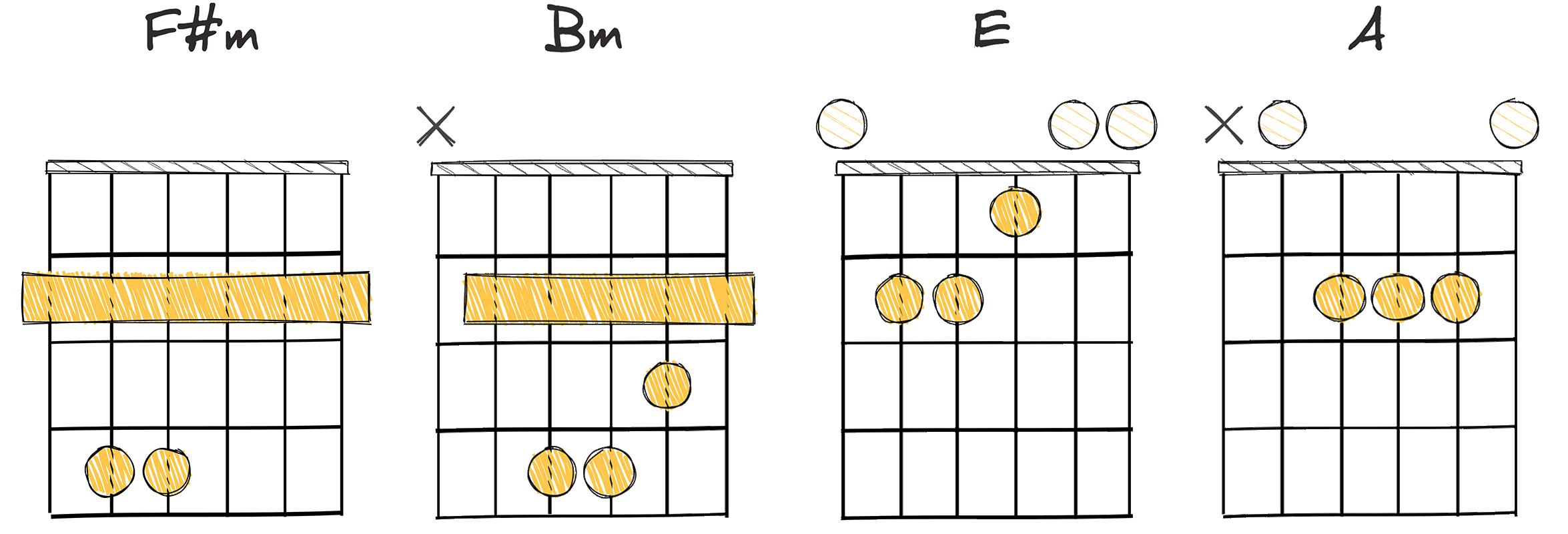
The vi-ii-V-I (6-2-5-1) chord progression offers an exciting mix of tonal shifts suitable for the EDM genre.
Famed for its striking cadences and satisfying resolution, this progression is a must-know for any aspiring EDM music producer.
Though not as popular as the I-IV-V progression, the vi-ii-V-I progression has a rich history, having been extensively used in different genres of music, ranging from classical to pop and jazz.
This chord progression is identified with certain temporal periods due to its appearance in popular songs of those times, reinforcing its rich legacy in music.
However, what distinguishes this progression is its understated complexity and flexibility, making it a powerful tool in the hands of creative producers.
Complexity here does not indicate difficulty.
In fact, the vi-ii-V-I chord progression is easy to play, yet offers incredible depth because of the variety of modulations and emotional contexts it can provide.
The concept of ‘easy to play, hard to master’ perfectly embodies this chord progression.
For those who are new to chord progressions, in the key of A major this would be represented by the chords F#m – Bm – E – A.
This harmonic combination sets a distinctive tone to the song, giving it an unforgettable character.
Importantly, the vi-ii-V-I progression’s flexibility means it can be creatively manipulated to fit an array of EDM sub-genres.
Whether you’re producing House, Trance, Dubstep, or Techno, this progression is a potent tool for capturing expressive musical nuances.
Different inversions of chords within the vi-ii-V-I sequence can create various textures in your music.
Therein lies its power: diversity within structure, an essential component of EDM music production.
So, whether you’re a seasoned producer or just starting out in the world of electronic music production, the vi-ii-V-I progression is a valuable addition to your musical toolkit.
A mastery of this classic progression provides any creator of music with a firm grounding in harmonic principles, boosting the sophistication and dynamics of their sound.
In the world of EDM, such a progression could be the difference between a good track and a standout track.
IV-ii-vii°-I (4-2-7-1)
A sequence both complex and melodious that can add nuance to your compositions..
The IV-ii-vii°-I progression in the key of G major, manifesting as C – Am – F#dim – G, presents a musical journey rich in emotional texture. Starting with the comforting C chord, it shifts into the introspective Am, adding a shade of melancholy. The introduction of the mysterious F#dim creates a compelling tension, like a question hanging in the air. This is masterfully resolved with the bright and reassuring G chord, creating a satisfying and complete sonic experience that’s both complex and accessible.
- Difficulty: Advanced
- Example: C – Am – F#dim – G (Key of G major)
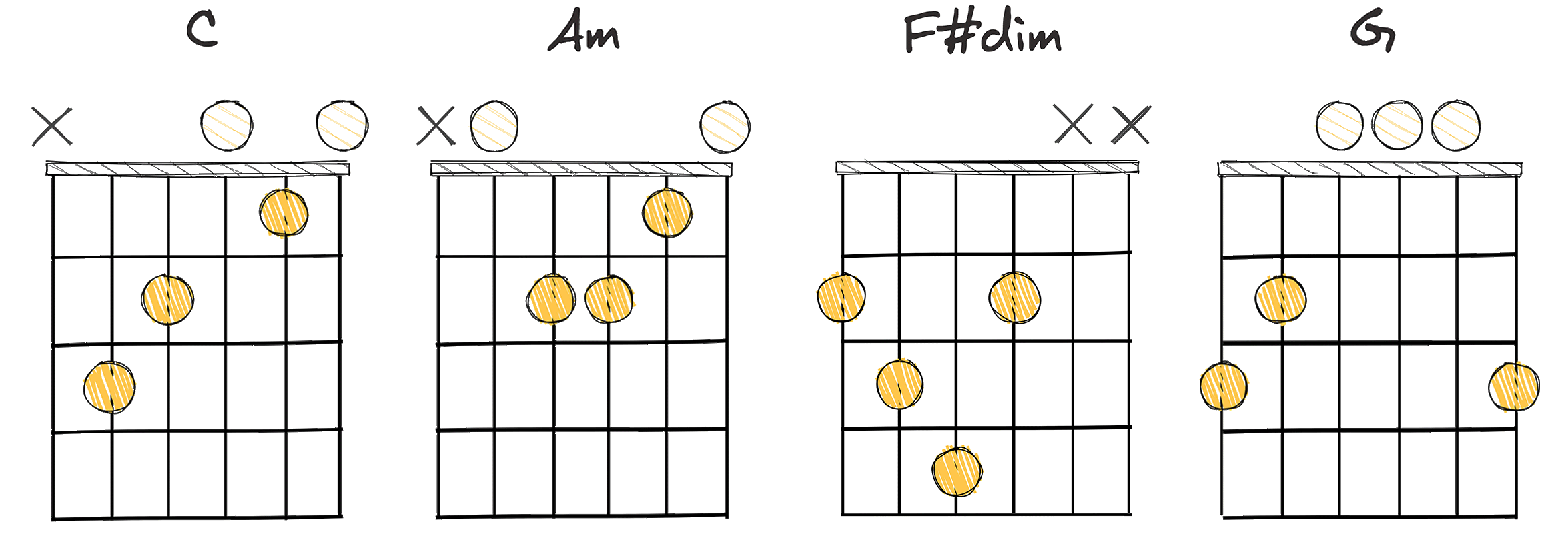
As an aspiring EDM producer, the exploration of various chord progressions is key to crafting distinctive soundscapes.
One such intriguing progression is the IV-ii-vii°-I (4-2-7-1), a sequence both complex and melodious that can add nuance to your compositions.
Historically rooted in classical traditions, this progression provides a mixture of emotions, opening doors to creative experimentation.
Its interplay of major and minor chords offers a harmonic palette rich in feelings, providing an exciting contrast to the listener.
In the key of G major, this progression takes the form of C (IV) – Am (ii) – F#dim (vii°) – G (I).
The transition from the warmth of the C chord to the melancholic Am and the tense F#dim creates an appealing musical journey, finally resolving with the satisfying and homey G chord.
Utilizing the IV-ii-vii°-I in the realm of EDM can breathe life into your music, offering a balanced complexity without overwhelming the danceable quality that defines the genre.
Its applicability across various EDM sub-genres can facilitate the crafting of compelling melodies and rich harmonies, allowing producers to weave a fascinating musical tale.
So, whether you’re experimenting with a new beat or seeking a fresh take on a classic sound, the IV-ii-vii°-I progression, with its blend of harmonic tension and resolution, can be a valuable asset in your EDM producer’s toolkit.
ii-vi-IV-V (2-6-4-5)
A melodic backbone offering emotional depth to a pulsating EDM track.
The ii-vi-IV-V (2-6-4-5) progression is a popular chord sequence in EDM (Electronic Dance Music), which creates a distinctive circular, harmonious flow to the music. This progression provides a sense of tension and release, making it particularly effective in uplifting, emotive EDM tracks.
- Difficulty: Intermediate
- Example: Em – Bm – G – A (Key of D major)
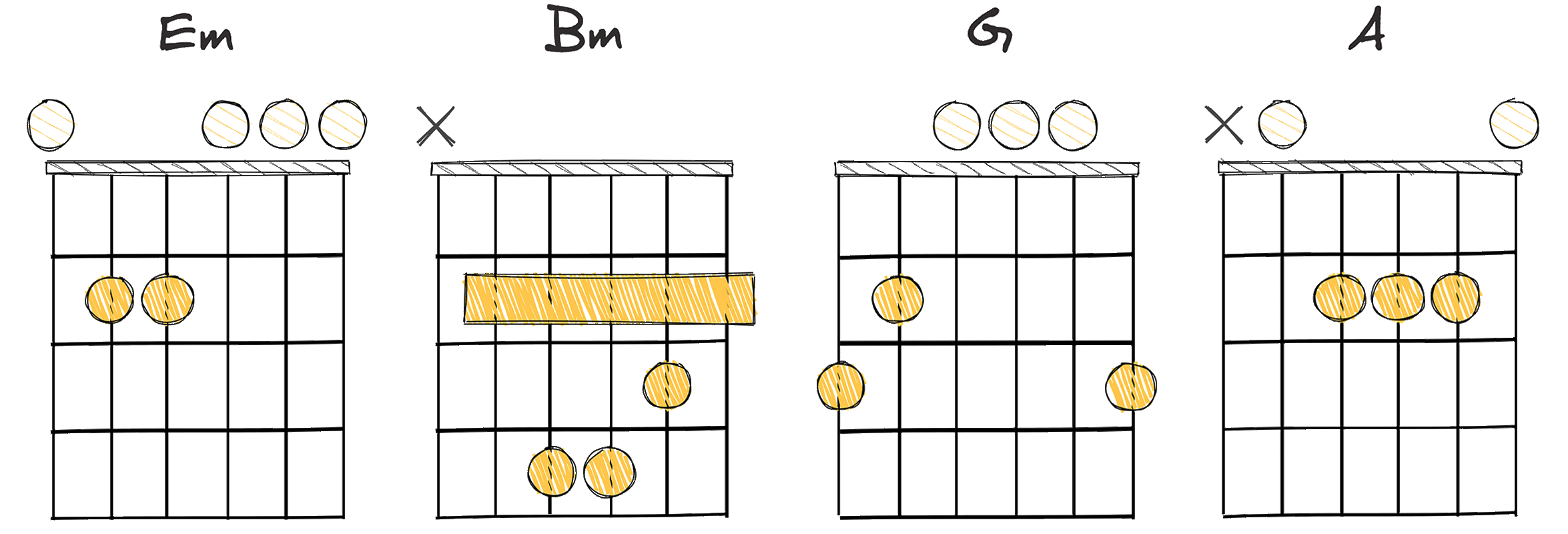
In the vast landscape of musical composition, chord progressions serve as the main building blocks of rhythm and harmony. The ii-vi-IV-V (2-6-4-5) chord progression is one such significant structure in the Electronic Dance Music (EDM) genre.
The history of this chord progression dates back to the inception of music itself and is prevalent across many music genres.
Its simplicity and sonic appeal have contributed to its lasting legacy and popularity over the centuries.
Known for its ease of play, the ii-vi-IV-V chord progression is versatile and blends well with various song structures and tempos.
This attribute makes it a favorite among beginners and seasoned music producers alike.
Translated into chords, the ii-vi-IV-V progression in the Key of D Major gives us: Em – Bm – G – A.
These chords collectively create an aurally pleasing and harmonically balanced rhythm.
This is a characteristic feature of how the ii-vi-IV-V chord progression seamlessly integrates with a song’s melody and rhythm.
This integration makes ii-vi-IV-V a reliable chord progression that creates a captivating rhythm without overshadowing the song’s main melody.
The flexibility of this progression allows it to adapt to any changes in the melody or rhythm.
This versatility is why it is widely used in EDM, a genre known for its intricate and often complex melody lines.
Furthermore, its sonic consistency helps maintain a balance between unpredictable melodic lines and a steady rhythmic base.
These factors consolidate its position as an essential chord progression in the EDM producer’s toolkit.
Understanding this chord progression and its operation in different musical contexts enhances a producer’s ability to create diverse and richly textured EDM tracks.
It gives them the skills to design more dynamic and expressive musical landscapes.
The ii-vi-IV-V progression’s rhythmic structure also allows for experimentation with chord inversions and voicings.
This flexibility enables producers to add their unique touch to their compositions.
The Bottom Line
Having explored various chord progressions, it becomes clear that these sequences form the backbone of many musical pieces.
Their importance in producing the overall auditory aesthetic of a piece cannot be overstated.
From simple three-chord progressions like the I-IV-V, to more complex combinations like the vi-ii-V-I, each provides a unique emotional influence on the composition.
It’s evident that the appropriate use and understanding of these progressions is vital in creating impactful, resonant music.
Therefore, music creators must not only learn these structures but also practice and experiment with them, pushing the limits of their creativity.
In love with guitars, and gear; expert in all things music! Been writing about guitars for about 5 years and counting. Born in the ’90s. Alma Mater: University of Havana. Always curious, trying to understand the world. #TeamFender




